Do you have an ear pinner? Why do horses pin their ears at you?
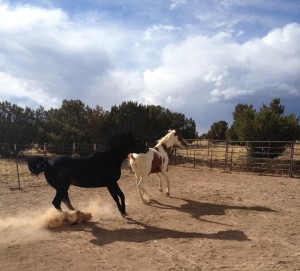
They do it to herd members all the time, usually because some other horse is encroaching on their space, or food, or they want to move somebody. What I notice is that many times a horse will accept the ear pinning gesture from another horse but not from a human (the human coming to take territory, not necessarily pinning his or her ears!). They will also do it if they are experiencing physical pain, which must be considered in the whole picture.  A trainer recently wrote to me about this horse: “Recently I tried to do something in liberty with a young Lusitano, that is not a dominant horse, and is more shy, normally very gentle and respectful with other horses too. But when I asked him to move and my position is beside him, in the beginning he flattens his ears, then he goes.
A trainer recently wrote to me about this horse: “Recently I tried to do something in liberty with a young Lusitano, that is not a dominant horse, and is more shy, normally very gentle and respectful with other horses too. But when I asked him to move and my position is beside him, in the beginning he flattens his ears, then he goes.
It’s also important to recognize when a horse is simply putting her ears back halfway so she can listen to you. I was made aware of that lately with my mare who liked to have her
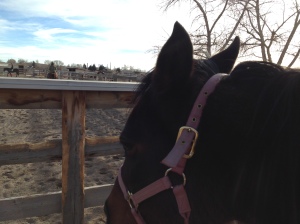
ears back so she could determine when I was going to mount, and what I might ask of her. We didn’t know each other very well at this point, but she taught me something about listening. It was more of a “I want to make sure I understand you” gesture than ear-flattening mad. I began to do more things with her on the ground and just stood and breathed with her for awhile, so she could feel more in touch with me as I mounted and gathered up the reins. Horses can approach liberty training the same way – as a job – but then they soon learn that it is not about performance, it’s about connection. It bears a semblance to what they do with other horses. Some horses who have been abused or roughly handled may have flashbacks for awhile to behaviors of people they didn’t like, and get stuck in their training. It’s all about going back to the foundational training at liberty, so the horse can regain the ease and comfort of those foundations that they know so well, and are stamped in their DNA. When I have a horse who has had a flashback, I take him back to basics, quiet and soothing words, something completely lacking of expectations, and non-aggressive. I find the one thing he most enjoys at the moment, and let him do that. The same approach can be used with ear pinning. I often ignore what might be perceived as “bad” behavior to focus on the good. But because ear pinning signals that the horse might do something else – bite or kick – I generally hold up my hand like a policeman, take a step forward toward the horse and make some warning sharp noise like “Ah!” This is so the horse recognizes my energy and does not think he can intimidate me or blow through me. Although we are imitating some horse language, we don’t want to engage in horse behavior that can cause escalation. We model behavior that we’d like to see in the horse.
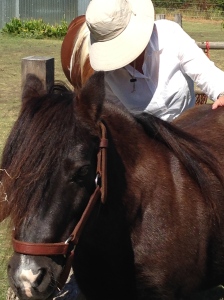
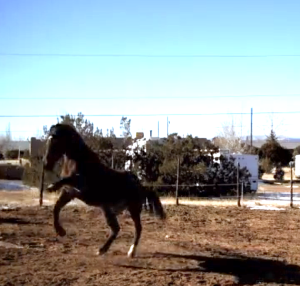
A horse who charges you or will whirl around and kick you is a completely different matter. In most situations, it’s best not to retreat and to instead take that step forward but if the horse is bent on running you over, then it’s prudent to step to the side and/or get out of the space altogether. I do not work with charging horses in the same space until they get past that desire to do that. I also want to make sure I’m out of range of the hind legs if I feel the horse’s energy is high and he might whirl and kick. While I’m doing these things to protect my own safety, I am also conscious of the horse being in possible pain. I don’t want to do anything to end the conversation and then lose a fuller understanding of what he might be suffering. So without seeing the horse in question, I am alert to the ear pinner as not just a crabby horse that doesn’t want to interact, but as a horse that is trying to tell me that he hurts somewhere. When it is a cinch issue, he may have stomach pain. Pelvic pain may present by not wanting to move his legs or kicking out and so on. What I intended by writing this was really to suggest looking at the problem – ear pinning – globally, while at the same time looking at what works and doesn’t work for the horse. That way, it will be easier to determine if the horse is pinnng his ears, or biting or kicking, because he dislikes something, or is in pain.
***
(copyright: Susan Smith, OrthoHorse)
Services: Bodywork (Ortho-Bionomy for people, Equine Positional Release/Equine Ortho-Bionomy): private sessions (including Horse & Rider sessions), tutorials, phone consultations, distance healing communication and gift certificates Liberty Training: clinics, mini-clinics, workshops, private and semi-private sessions, tutorials, consultations: by appointment: 505.501.2478 or emailing susansmith@orthohorse.info
Winter Lessons – semi-private, private and small group sessions. Scheduling now. Contact me for details.
New on the schedule for 2014:
February 8, OrthoHorse Tutorial — Arrowhead Ranch, Santa Fe, Susan Smith, Advanced Registered Practitioner Ortho-Bionomy 9:30 a.m.-12:30 p.m. If this one fills up we may open an afternoon session.
February 28, OrthoHorse Tutorial, Sound Horse Systems, DeLand, Florida. (see flyer below)
March 1-2 Horses at Liberty Foundation Training Weekend Clinic, DeLand, Florida. Contact Anne Daimler, tdaimler@cfl.rr.com (386-822-4564) or myself for registration and information. Space is limited. OrthoHorse Tutorial also offered before the clinic: February 28 (see flyers below). An afternoon Tutorial may be offered by popular demand.
April 4 OrthoHorse Tutorial, Spirit Horse Ranch.
April 5-6 Spirit Horse Ranch Liberty Foundations Clinic, Jones Oklahoma, Presented by trainers Ruella Yates and Susan Smith. Contact Ruella Yates ruella@libertyfoundations.com, (405-771-4274) or myself for registration and information. Space is limited. 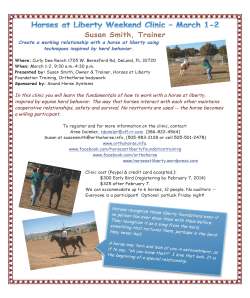




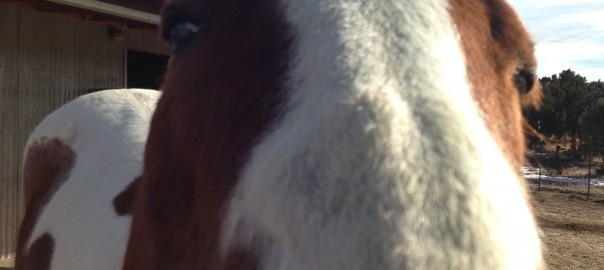
Very nice exploration of ear pinning, and varied reasons for that, including pain. Often, as you wrote, it is a listening position. Thanks for another great blog post!
Ruella Yates
Spirit Horse Ranch
Liberty Foundations
Thanks, Ruella. The more I look into ear pinning, the more expressions I find!